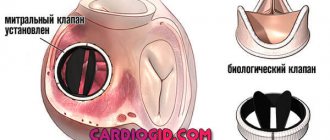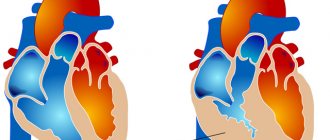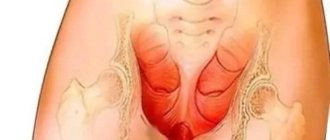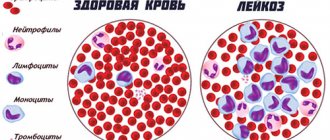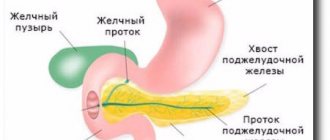Atrophic gastritis is an inflammatory process in the mucous membrane and glands of the stomach, in which the number of normally functioning cells is significantly reduced.
Atrophy of the mucous membrane and glands is characterized by the fact that the cells of the stomach change, their structure is gradually disrupted, then they die and they do not perform their functions of secreting mucus, enzymes, and absorbing nutrients.
In chronic atrophic gastritis, the symptoms of the disease are caused by a significant reduction in the mucous layer of the stomach, a decrease in the production of gastric juice and poor absorption of food.
Table of contents
- Atrophic gastritis - what is it? How often does atrophic gastritis turn into cancer?
- Causes
- Symptoms
- Symptoms
- Prognosis for treatment of atrophic gastritis
Pathogenesis of the disease
Decreased stomach acid levels are quite serious. What is dangerous about atrophic gastritis is that in medical circles it is recognized as a precancerous disease.
What is atrophic gastritis? This is a violation of the renewal of glandular cells of the stomach. Normally, they are born, function, die and are renewed. This is a property of all normal, healthy cells in the body.
The acid-base environment of the gastric mucosa can be neutral, alkaline and acidic. Helicobacter pylori bacteria, living in an acidic environment, greatly change the condition of the stomach walls and its pH value. De Nol is a remedy that effectively fights stomach-destroying bacteria.
Each cell of the gastric glands has its own profile, or specialization. The main role in the development of pathology is played by the fact that under the influence of immune reactions, cells stop producing gastric juice.
Normally, constant cell regeneration should occur: worn out and dying cells are replaced by healthy ones. Usually, in a person who does not suffer from this disease, the gastric mucosa is renewed every week. In the patient, the restoration of the gastric mucosa is impaired, and its walls may atrophy.
When regeneration is impaired, glandular cells produce mucus instead of hydrochloric acid. It has some protective functions, but does not play a noticeable role in the digestion process. The acidic environment degenerates, the acidity becomes weak, and as a result the stomach generally ceases to secrete hydrochloric acid and the enzymes necessary for digestion.
Subsequently, the defective cells begin to produce similar ones - immature and incapable of secretory function. Restoration of the mucosa against the background of such pathogenesis is impossible.
Atrophic gastritis - what is it?
Atrophic gastritis is an inflammatory disease of the stomach, characterized by atrophy of the mucous membrane, death of the glandular apparatus of the stomach, and disruption of regeneration processes. The process, without exacerbation, occurs against the background of a moderately pronounced inflammatory reaction. CAH is a morphological concept; to verify the diagnosis, it is necessary to perform an FGDS with a biopsy.
The endoscopic picture is quite typical: the gastric epithelium is flattened, in places replaced by intestinal epithelium with typical enterocytes and goblet cells. In the surviving parietal cells (stomach cells, their function is the synthesis of hydrochloric acid), signs of atrophy are detected (vacuolization of the cytoplasm, its rarefaction, reduction of mitochondrial cristae).
How often does atrophic gastritis turn into cancer?
Metaplasia that accompanies CAH, from the point of view of oncologists, is a harmless process, simply one type of differentiated tissue is replaced by differentiated tissue of another type. However, it must be remembered that this replacement occurs in an anatomical area that is not adapted for the normal development of this new tissue. As a result, dysplasia occurs (the development of new tissue cells and their differentiation are disrupted, followed by disruption of tissue architectonics). Dysplasia goes through several stages, resulting in the formation of undifferentiated small cells capable of rapid reproduction. Atrophic gastritis turns into cancer.
The likelihood of such a transition is not currently disputed by any scientist. A huge amount of work has been done, many scientific conferences have been held on the topic “Atrophic gastritis and cancer.” Statistics say that 15% of all cases of CAH develop into cancer. The importance of these findings can hardly be overestimated; doctors have received a scientifically based basis for the early detection of stomach cancer.
Causes
The two most significant causes of pathology are generally accepted:
- H. pylori infection;
- autoimmune processes.
When infected with H. pylori, atrophic processes in the stomach develop as a result of long-term chronic inflammation. H. pylori first settles in the antrum, then in the body of the stomach, and then throughout the entire mucous membrane of the organ, initially causing inflammation and then atrophy of the gastric mucosa.
With autoimmune gastritis, the disease develops very quickly; autoimmune antibodies are formed not just to the cells of the mucous membrane, but also to their organelles and even individual protein molecules. The reasons for the appearance of antibodies are not clear, but it is known that in order to trigger the autoimmune cascade, the antibody titer must reach a certain critical value, but various factors can affect the speed of this process:
- genetic characteristics;
- somatic diseases;
- hypovitaminosis;
- bad habits;
- starvation;
- eating disorders;
- chronic infections.
Prevention
Atrophic gastritis is a chronic disease of the digestive tract. Its primary prevention is a healthy diet and personal hygiene. Secondary measures to prevent the disease include regular examination by a gastroenterologist. The disease can develop in an asymptomatic form. Only a doctor can detect the progression of the disease.
Prevention measures:
- replenishment of vitamins in the body;
- strengthening the immune system;
- rejection of bad habits;
- taking medications according to instructions;
- exclusion of a sedentary lifestyle;
- timely treatment of diseases of the digestive system;
- adherence to healthy eating rules;
- excluding neglect of personal hygiene rules.
What is focal atrophic gastritis
Focal atrophic gastritis is a form of CAH when not the entire coolant is affected by the atrophic process, but only its individual segments.
Between the foci of atrophy there are areas of hyperplastic epithelium with preserved glandular apparatus. These areas of the mucosa secrete an increased amount of hydrochloric acid, trying to compensate for the function of the lost glands in atrophic foci. Depending on whether areas with atrophy or without atrophy (with preserved function) predominate, a hypoacid or hyperacid state occurs (low or high acidity of gastric juice).
Symptoms of focal atrophic gastritis
OAS develops slowly, symptoms are mild. The patient is concerned about:
- nausea;
- belching;
- lack of appetite;
- flatulence, rumbling in the stomach;
- unstable chair.
Menetrier's disease, atrophic hyperplastic gastritis, stands apart. The etiology of the disease is unknown. The disease has diffuse and focal forms. The focus of atrophic hyperplastic gastritis is a proliferation of epithelial folds. With FGDS, intestinal metaplasia, proliferation and hypertrophy of the mucous glands are observed in combination with almost complete atrophy of the main acid-producing glands. At the onset of the disease, a hyperacid state is observed, followed by achylia (lack of pepsin and hydrochloric acid).
Symptoms of focal atrophic gastritis:
- stomach ache;
- feeling of fullness in the stomach;
- vomit;
- diarrhea;
- lack of appetite.
Treatment of focal atrophic gastritis with drugs
The main drugs for the treatment of chronic atrophic gastritis can be divided depending on the acidity of the gastric juice.
For the treatment of chronic gastritis with focal atrophy, occurring against the background of a hyperacid state, with and without erosions, the following drug treatment is used:
- Antibiotics: Amoxicillin, Clarithromycin, Arvicin, Kriksan, Panclave. Any treatment regimen for the eradication of Helicobacter pylori includes at least two drugs with antibacterial action. After a course of antibacterial drugs, probiotics (Lactobacterin, Biobakton) and prebiotics (Duphalac) are prescribed.
- To reduce the concentration of H+ ions, proton pump inhibitors (Omeprazole, Pariet, Nolpaza), IGR (Ranitidine, Famotidine), antacids (Almagel A, Phosphalugel) are prescribed.
- Cytoprotectors – De-nol, Vikalin, Venter, Rebagit.
- To eliminate dyspeptic disorders, prokinetics are used - Trimedat, Domperidone, Cerucal.
- In case of severe pain, antispasmodics (Papaverine, No-shpa) or M-cholinergic drugs (Platifillin, Metacin), Befungin are prescribed.
For focal atrophic gastritis with reduced secretory function, the following drug treatment is used:
- In case of insufficient acid formation, replacement therapy is prescribed, which the patient will have to take for the rest of his life (Acidin-pepsin, Abomin Pepsidil).
- If enzymatic activity is impaired, enzyme preparations (Creon, Pangrol) are prescribed.
- Preparations that restore mucous membranes (Solcoseryl, Riboxin, Aloe vera, Actovegin)
- Vitamin B₁₂.
- Plantaglucide is used for secretory stimulation.
Symptoms
A distinctive feature of atrophic gastritis is the likelihood of developing an inflammatory process without pain. The patient may experience discomfort in the digestive system under the influence of certain factors. With pathology, deviations in the digestion of food and bowel movements are sure to occur.
In most cases, there are no acute pains with this disease. Severe pain syndrome appears only in the presence of concomitant complications.
General symptoms:
- aching pain in the area of the digestive organs after eating;
- pallor, dry skin;
- lack of appetite, weight loss;
- increased bleeding
- excessive sweating;
- Iron-deficiency anemia;
- rumbling in the stomach after eating;
- alternating constipation with diarrhea;
- belching air with an unpleasant odor;
- feeling of fullness in the intestines;
- excessive fatigue of the body;
- general weakness of the body.
What is diffuse atrophic gastritis
Chronic diffuse atrophic gastritis is a form of chronic inflammation in which the glandular apparatus of the stomach is affected, and the entire mucous membrane of the organ or most of it is involved in the process.
It should be remembered that diffuse atrophic gastritis is a continuous, pathological process, which means that any division into stages and classification is very conditional. The following stages of the process are distinguished:
- The superficial form of atrophic gastritis is the 1st stage of the disease, when the pathological process affects only the biochemistry of the cell, without externally manifesting itself.
- Moderate form of hypertension (stage 2) - although biochemical changes can be detected throughout the entire mucosa, only a part of the cells of the glandular apparatus undergo atrophic changes.
- Diffuse atrophic gastritis (stage 3) is a severe form of the disease. The pathological process involves almost the entire coolant - the fundus, body and antrum. The secretory function of the stomach decreases sharply. Insufficiency of the cardia occurs, the functioning of the pyloric sphincter is disrupted with the development of reflux gastritis. If the disease is not treated, the functioning of the entire digestive tract is disrupted with symptoms of bulbitis, duodenitis, and cholecystitis. With further development of intestinal metaplasia, the occurrence of cancer is very likely.
Hyperplastic gastritis is a disease of unknown etiology, accompanied by hypertrophy of the coolant, while the glandular apparatus undergoes atrophy. This form of the disease is dangerous because polyps appear on the surface of the thickened folds of the stomach, the likelihood of malignancy increases sharply, in addition, the folds are often covered with erosions with a hemorrhagic component. In both of these cases, surgical treatment is required. If bleeding recurs, the stomach is completely removed.
Symptoms of diffuse atrophic gastritis
Diffuse atrophic gastritis is manifested by nonspecific symptoms:
- white coating on the tongue;
- dryness and unpleasant sensations in the mouth;
- abdominal discomfort;
- belching;
- unstable stool (constipation alternates with diarrhea);
- loss of appetite.
Treatment of diffuse atrophic gastritis with drugs
Treatment of diffuse atrophic disease includes the following groups of drugs:
- Replacement therapy drugs – Acidin-pepsin, Abomin.
- Agents that stimulate the acid-producing function of the parietal cells of the stomach: Mineral waters (Essentuki, Morshinskaya, Narzan);
- Rose hip decoction;
- Plantaglucide;
- Limontar.
Gastritis against the background of mucosal atrophy diet
People who suffer from atrophic gastritis definitely need to eat right.
People who suffer from atrophic gastritis definitely need to eat right. To do this, the diet should be based on the following products:
- broths;
- porridge;
- mineral water;
- mousses;
- non-acidic dairy products;
- jelly.
During an exacerbation of gastritis, all food should be consumed in crushed form. Moreover, it is advisable to cook it exclusively by steaming.
You should avoid consuming the following foods:
- too hot and too cold dishes;
- sour foods;
- smoked meats;
- pickles;
- spicy dishes;
- fried foods;
- spices;
- sauces;
- canned foods;
- easily digestible carbohydrates;
- alcohol;
- coffee;
- carbonated drinks.
Nutrition should be balanced - it is advisable to coordinate your menu with your doctor. Protein products should predominate in the diet, since they stimulate the synthesis of new cells. It is recommended to limit the amount of salt and spices. You need to eat more often, but in small portions at certain intervals.
Autoimmune atrophic gastritis
Autoimmune atrophic gastritis is an atrophic process in the gastric mucosa caused by antibodies synthesized by the body itself. The etiology of the disease is not fully understood.
In autoimmune atrophic gastritis, the symptoms of the disease reflect the result of the action of autoantibodies on the gastric mucosa - these are the symptoms of diffuse atrophic gastritis:
- feeling of fullness and discomfort in the abdomen;
- nausea, belching,
- white coating on tongue
- flatulence, rumbling in the stomach,
- unstable chair.
It is currently impossible to eliminate autoimmune lesions of the mucous membrane. Steroid hormones are prescribed when gastritis is accompanied by pernicious anemia. In all other cases, the side effects of steroids are greater than the effect of them.
Treatment tactics and medications are the same as for diffuse atrophic gastritis.
Possible consequences
If a person is rarely bothered by the symptoms listed above, then there is no particular danger, but it is worth consulting a doctor so as not to miss the development of a dangerous disease. After all, these signs indicate not only the development of gastritis, but also indicate more serious ailments, among which is cancer.
With prolonged symptoms, the patient may develop duodenitis - inflammation of the duodenum, and if the problem spreads to the esophagus, the person is diagnosed with esophagitis. Constant irritation of the mucous membrane causes the development of peptic ulcers of both the intestines and stomach. The consequence of such problems can be the formation of kidney stones.
Loading…
AG with low acidity
Atrophic gastritis with low acidity occurs over a sufficiently long period, when the number of acid-producing cells decreases to a critical level. In this case, the digestive processes are disrupted, and symptoms of the disease appear:
- feeling of fullness and heaviness in the stomach;
- decreased appetite;
- painful belching;
- bitterness in the mouth;
- hypersalivation.
Diagnostics includes: FGS study, pH measurement of gastric juice, detection of Helicobacter pylori infection.
Treatment includes:
- replacement therapy (Pepsidil, Abomin)
- enzyme preparations (Creon, Festal);
- vitamin therapy (vitamin B₁₂);
- secretory stimulation (Plantaglucid).
Diagnostics
When diagnosing atrophic gastritis, laboratory and instrumental methods are used. At the initial stage of the examination, the doctor examines the patient’s complaints, collects anamnesis and assesses the general clinical picture of his health. If a specialist suspects complications, an additional consultation with specialized doctors may be prescribed.
Diagnostic methods:
general analyzes of biological material;- biochemical analysis of blood and urine;
- examination of feces for occult blood;
- Abdominal CT scan;
- gastrography;
- endoscopic examination;
- radiography;
- test for Helicobacter pylori;
- pH-metry.
AH with high acidity
Atrophic gastritis with high acidity occurs in the first stages of the atrophic process, when small areas of mucosal atrophy are surrounded by normal tissue with preserved glandular apparatus. In response to a decrease in the number of cells capable of secretion, the secretion of healthy cells increases. At the very beginning, this is a compensatory mechanism, which quickly turns into a pathological one that needs to be treated. An increased amount of acid acts on the gastric mucosa, causing the formation of erosions and even ulcerative changes.
Signs of a hyperacid state:
- constant feeling of discomfort in the stomach;
- moderate abdominal pain;
- heartburn;
- belching, nausea;
- feeling of bitterness in the mouth.
Hyperacid conditions are usually easier to treat than hypoacid conditions. The following groups of drugs are used for this:
- Antibiotics (eradication of Helicobacter pylori)
- Drugs that normalize the pH of gastric juice - proton pump inhibitors (Omez, Pariet), IGR (Famotidine), antacids (Almagel).
- Cytoprotectors (De-nol).
- Prokinetics (Domperidone).
- Antispasmodics (No-spa).
Why is eradication necessary?
Eliminating Helicobacter helps:
- suppress further development, the addition of other bacteria, and the growth of antibiotic-resistant strains;
- reduce the duration of treatment for gastritis;
- reduce the negative effects of medications;
- bring the acidity of gastric juice closer to normal.
The most effective treatment regimens are those that combine tetracycline and penicillin antibiotics and Metronidazole (Trichopol). The modern product De-Nol, a drug based on bismuth citrate, is actively used. Doses are selected individually.
How to restore the gastric mucosa with atrophic gastritis
Currently, it is generally accepted that massive antibacterial therapy, together with complex treatment, makes it possible to interrupt the pathological process in the mucosa even in advanced cases, and can be considered as the prevention of stomach cancer.
However, this statement is not accepted by everyone. Opponents speak out more cautiously. They believe that it is impossible to achieve complete restoration of the mucosa after atrophy with metaplasia, but it is quite possible to stop the process and influence its spread throughout the organ using modern treatment methods.
Treatment of the chronic form of the disease
If there are no clinical manifestations of the disease, medications are not taken. Treatment of atrophic chronic gastritis is prescribed by a doctor, taking into account the stage of cell death and the volume of epithelium involved. Concomitant diseases and the patient’s medical history are also taken into account.
Drug therapy
The treatment regimen includes drugs to relieve symptoms and stimulate stomach functions:
- the elimination of severe pain is carried out with anticholinergic drugs - Metacin, Platyfillin, Gastrocepin;
- for spasms, take No-Shpu, Papaverine, Halidor;
- improvement of motor function – Motilium, Cerucal;
- significant death of the glands is compensated by natural gastric juice - Abomin, Pepsidil.
Drug therapy is combined with vitamins based on folic acid and iron. To maintain stomach functions and slow down cell transformation, it is recommended to periodically visit sanatoriums in the Stavropol Territory with mineral springs.
Restoration of the gastric mucosa in the erosive form of the disease is carried out using enveloping agents. These include Actoverin, Retabolil, and sea buckthorn oil.
Treatment of the atrophic form of gastritis in women and men is carried out according to the general scheme. The manifestation of symptoms does not depend on gender. For pregnant women and breastfeeding women, the list of drugs is limited. Allowed means:
- Gastrofarm;
- Maalox;
- Drotaverine, No-Shpa;
- chamomile, mint;
- Valerian root:
- Betaine-pepsin.
Atrophic gastritis should be treated with medications after consulting a doctor, since the disease has different forms and manifestations. Incorrectly selected medications can aggravate the situation.
Diet
In case of exacerbation of the disease, follow diet No. 1. Small meals, 5–6 times a day. Food is consumed warm and temperature changes are not allowed. Coffee, chocolate, canned food, and spices are excluded from the menu. Food is steamed, boiled, stewed. Eating fried, spicy and fatty foods can cause intoxication and prolong the acute phase of the disease. Allowed food products:
- lean meat;
- soups with a second broth;
- well-cooked cereals;
- vegetable puree;
- crackers;
- jelly.
Do not eat fresh fruits during an exacerbation of the disease. Coarse fiber injures the mucous membrane, slowing down the healing of damaged areas.
During the period of remission, therapeutic diet No. 2 is prescribed, which is designed for people with low stomach acidity. The diet should be varied, include a lot of protein foods and nutrients. Particular attention is paid to products that enhance the production of gastric juice. To improve the functioning of the glands you need to eat:
- apricots;
- cabbage;
- beans;
- raisin;
- figs;
- sea fish;
- liver;
- peas;
- turnip.
Enzyme therapy
With gastritis, the production of substances that activate the action of enzymes is disrupted; in addition, the synthesis of enzymes is reduced, which leads to digestive disorders. Enzyme preparations improve digestion, reduce flatulence and bloating, and improve the overall well-being of patients.
Enzyme therapy for chronic atrophic gastritis includes:
- Preparations containing pepsin promote the breakdown of proteins (Pepsin K, Acidin-pepsin) and are used as replacement therapy for atrophic gastritis.
- Pancreatic enzymes containing trypsin, amylase, lipase (Mezim, Creon). These drugs eliminate nausea, bloating, and flatulence.
- Combined preparations containing pancreatin, supplemented with hemicellulose, bile (Festal, Panzinorm). These drugs are usually used for hypoacid gastritis.
- Combined enzymes with the addition of plant enzymes and vitamins to pancreatin (Wobenzym). Wobenzym contains: amylase, lipase, pancreatin, trypsin, chymotrypsin, bromelain, papain, rutin. Wobenzym stimulates the activity of macrophages against pathological cells, thereby preventing the formation of tumors. These properties determine the use of Wobenzym for atrophic gastritis.
Details about the phenomenon
To digest food, juice is formed in the stomach, which contains hydrochloric acid . With the help of this acidic environment, any product that enters the stomach will be broken down into useful substances and waste. Another important step is removing bacteria. For normal functioning, food must be supplied in the required quantities and not stagnate in the stomach.
Is it possible to cure atrophic gastritis completely?
To cure atrophic gastritis completely means restoring the mucous membrane to its normal state in histological and functional terms. It is quite possible to restore the mucous membrane at the beginning of the disease. If the process has gone far, most of the mucosa is affected by atrophy, there is intestinal metaplasia, it is unlikely to be able to cure the disease completely, but it is possible to transfer it into a phase of stable remission, improve the prognosis for life, and slow down further progression of the disease.
Chronic atrophic gastritis: prognosis for life
A fairly good prognosis for chronic atrophic gastritis in the initial stages, when mucosal atrophy can be prevented or stopped. Adequate antibacterial therapy and timely treatment of pernicious anemia (anemia due to B₁₂ deficiency) significantly improve the prognosis. In the stage of significant atrophy plus mucosal metaplasia, the risk of malignancy is significant.
Autoimmune gastritis is characterized by increasing mucosal atrophy. It is impossible to stop the process at the current level of scientific development. When the atrophic process reaches the stage of intestinal metaplasia, the development of an oncological process is quite likely.
The prognosis for hyperplastic gastritis depends on the form of the disease and the degree of hyperplasia. When polyps form on hypertrophied folds of the gastric mucosa, the risk of neoplasm is high.
Prognosis for treatment of atrophic gastritis
New drugs and treatment regimens have significantly improved the prognosis for the treatment of chronic atrophic gastritis. Of course, it is hardly possible to cure any chronic disease, including chronic atrophic gastritis, but it is quite possible to transfer the disease to a stage of stable remission. Hyperacid and initial forms of hypoacid gastritis without intestinal metaplasia respond well to treatment. Treatment of autoimmune and hyperplastic forms of gastritis is difficult.
Patients often ask the question: “How long do people live with atrophic gastritis?” Atrophic gastritis is unlikely to lead to death - it is not an oncological disease, but only an increased likelihood of its development.
Forecasted risks
The disease can affect all segments of the population, regardless of gender and age. According to research conducted by the World Health Organization, it affects about a twelfth of the population, to varying degrees of severity. To make a prognosis for the course of the disease, you need the opinion of a highly qualified gastroenterologist.
Based on all available data, the specialist draws conclusions about the patient’s current condition, gives an opinion on how much the disease complicates the medical history, and whether the disease will proceed safely or be accompanied by a set of complications.
There is no data on a decrease in life expectancy, provided that the recommendations of specialists are followed and the prescribed treatment is maintained.
The prognosis worsens as you move through the age group. Metaplastic processes occur much more rapidly and lead to malignancy in the vast majority of cases.
Treatment of atrophic gastritis with traditional medicine
Alternative medicine can be used in the treatment of CAH in addition to drug therapy; they help cope with the disease. It is hardly possible to cure hyperplastic gastritis, severe forms of multifocal (multifocal) or diffuse atrophic gastritis with these drugs.
The most effective folk remedies for the treatment of atrophic gastritis with signs of mucosal atrophy and erosive gastritis:
- vitamin juices: potato, cabbage juice, black currant juice, plantain juice;
- alcohol tincture of propolis (20 drops dissolved in a glass of water, taken 4 times a day);
- sea buckthorn oil (2 teaspoons of oil are diluted in a glass of warm milk, drunk in the morning before meals);
- oat decoction (5 tablespoons of oats, pour 1000 ml of boiling water, leave in a thermos for 12 hours, take 30 minutes before meals);
- mumiyo (3 grams of the substance are dissolved in a liter of boiling water, drink 200 ml once a day);
- kelp (freshly frozen kelp is placed in water and boiled until completely steamed, the product is taken as a separate dish).
Medicines that help restore mucous membranes
Medicines in this group include:
- Almagel . The medicine is available in the form of a suspension. It has an enveloping property and helps reduce gastric secretion. The effect of the medication is noticeable within 5 minutes after administration, the duration can reach one and a half hours. The daily dosage is 1 spoon three times a day.
- Gastal. Available in tablet form. The medicine helps reduce acidity. To achieve a therapeutic effect, the tablet should be dissolved after each meal. The maximum number of tablets per day for an adult should not exceed 8 pieces.
- Phosphalugel. Available in sachets containing the drug in the form of a gel. Can be used diluted with water. Among other things, it has cleansing properties - it removes toxins and eliminates flatulence.
What can you eat with atrophic gastritis and what can’t you eat?
In case of CAH, the basis of nutrition should be table No. 2 according to Pevzner. Rules for proper nutrition for CAH:
- meals should be regular, at the same time, in small portions, the number of meals increases;
- food should be boiled and warm;
- food should be crushed or finely chopped;
- tobacco and alcohol are excluded.
With atrophic gastritis you can eat:
- dietary meat (rabbit, veal), poultry (turkey, chicken);
- lean fish (pollock, pike);
- dried bread;
- quail eggs;
- fermented milk products (cottage cheese, cheese, fermented baked milk).
- sauerkraut in small quantities;
- porridge cooked in water (rice);
- vegetable broth soups;
- turmeric in very small quantities;
- vegetables (potatoes, zucchini, beets, cabbage, tomatoes);
- allowed ripe fruits and berries (apples, blueberries, watermelon, bananas, avocados, persimmons);
- honey;
- chopped nuts and seeds, sesame;
- diluted juices, tea with lemon, dried fruit compote, jelly, goat milk, mineral water.
What you should not eat to avoid aggravating the symptoms of atrophic gastritis:
- poorly digestible foods (fatty meat and fish, rye bread, smoked meats, mayonnaise, legumes, margarine);
- some types of cereals (millet, pearl barley and barley);
- irritating mucous membranes (turnips, radishes, fresh onions, garlic).
Undiluted juices, strong tea, coffee, kvass, and full-fat milk can provoke an exacerbation of atrophic gastritis.
Atrophic gastritis in the early stages is treated well, the prognosis is favorable. Untreated forms can degenerate into cancer, so it is important to begin treatment when the first symptoms appear.
Planned activities for a favorable prognosis
The prognosis for atrophic gastritis plays a significant role in a person’s life. It allows you to create the right treatment plan that will help avoid complications or minimize their consequences. Assessment and prediction of the development of stages of atrophic gastritis is carried out depending on the degree of inflammatory changes and deformations.
The greater the percentage of lost functionally active epithelial cells of the gastric mucosa, the higher the risk of developing pathologies. Risk groups for stomach cancer are formed according to the stages of development of atrophic processes.
The cascade theory of the clinical course of the disease makes it possible to identify in the early stages and stop the development of Helicobacter pylori, which is the initial link leading to the chain of consequences of the development of atrophic gastritis, using the eradication method. The course of antibiotic treatment is designed for two weeks. If residual traces of the bacterial background are kept secret, treatment is re-prescribed.
Early treatment of pernicious anemia, which is a consequence of atrophy of the epithelium of the gastric mucosa, has a good effect.
For a favorable prognosis, during the course of the disease it is important not only to adhere to the recommendations of doctors, but also to support the body with non-drug means.
People over 50 years of age suffer from complications much more often than younger people.
https://gastritinform.ru/gastrolekar.ru/gastrit/atroficheskij.html https://nmedicine.net/atroficheskij-gastrit/ https://nmedicine.net/atroficheskij-gastrit/ https://gastritinform.ru/landscape -kov.ru/skolko-zhivut-s-atroficheskim-gastritom/ https://gastritinform.ru/www.gastroscan.ru/patient/disease/01/03/

